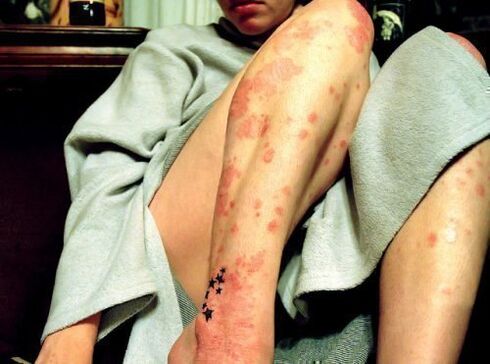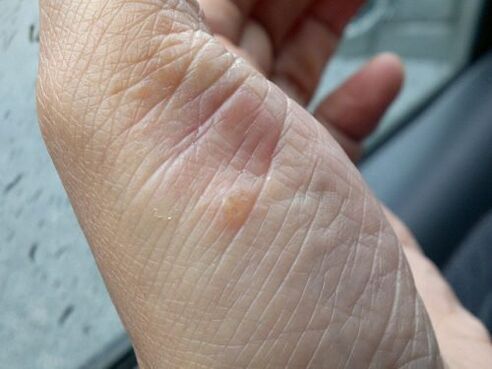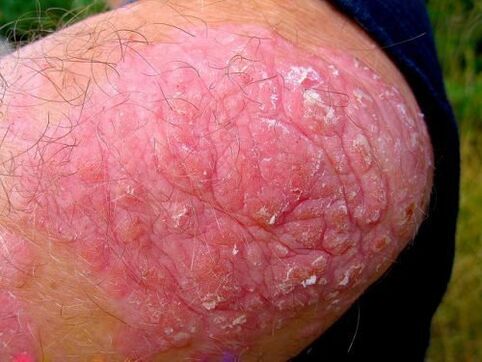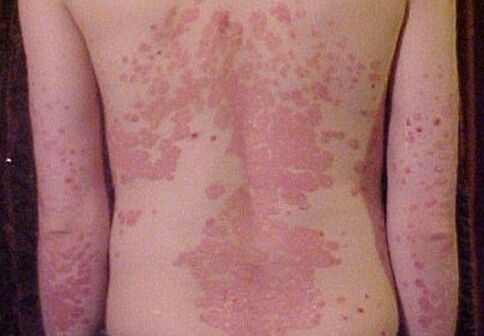Psoriasis is a pink rash with silvery scales. It is itchy and occurs in millions of people around the world. If a person or his relatives do not have such rashes, it does not mean that they will not appear. It is important to start treating the disease at an early stage of psoriasis and not to start it in a severe degree.

Psoriasis can be inherited, but not always.
Characteristics of the disease
Psoriasis is not an infection, and the cause of its occurrence is considered to be a violation of the functions of the immune system. And also the disease can be the result of external factors, skin injuries, stress, alcohol, antibiotics, infections.
The sores can cover any part of the body. Rashes are especially common on the arms and legs. They also occur on the palms, feet, scalp, and nails.
Psoriasis is a chronic disease that has an undulating course. The person may experience periods of diminishing rash or cause an exacerbation. Relapses can be triggered by various external factors.
Psoriasis does not affect normal life and does not require constant hospitalization. Despite this, it is a serious pathology that brings a lot of disadvantages and limitations.

The manifestations of psoriasis may subside and become almost invisible.
Conditional division of psoriasis
There are several forms of psoriasis:
- vulgar;
- seborrheic;
- teardrop-shaped;
- palmar-plantar;
- psoriasis on the genitals.
The most common psoriasis is the common form of the disease. With him there are edematous rashes of bright color, accompanied by severe itching.
There are three degrees of psoriasis, depending on the size of the affected area:
- Lightweight. About 3 percent of the skin is affected.
- Way. The number of rashes varies from 3 to 10 percent of the skin surface.
- Heavy. Rashes occupy 10% or more of the skin surface.
Sometimes the disease invades the joints. It is the most serious degree, regardless of the percentage of the skin affected by the plaque. This can lead to the development of psoriatic arthritis, which is accompanied by pain and swelling of the joint parts of the bones.
There are three stages of psoriasis depending on the degree of exacerbation:
- progressive;
- Stationary;
- regressive.
Even a doctor may not always be able to recognize psoriasis at a particular stage. In many cases, special monitoring of the development of the disease is necessary. This will help determine whether the psoriasis is in remission or not.

Psoriasis vulgaris has a bright pink color.
Progressive stage
At the initial stage, psoriasis develops quite quickly. Various rashes appear on the arms, back, buttocks, and legs, which over time develop and form plaques. The progression of the disease is characterized by severe itching of the affected areas, which become wet and can cause infection.
Early psoriasis is treatable. Therefore, it is important to make the correct diagnosis on time. At the first symptoms of psoriasis at the initial stage, you should consult a doctor. Only he can determine the nature of the skin disease and the stage of its development.
You can independently understand what psoriasis looks like by some signs:
- Rashes appear in places where clothing is in close contact with the body. For example, on the arms in the elbow area, under the waistband of the pants, elastic bands.
- The itchy rashes are covered with gray scales.
- If you remove the scale, you can see thin, moist skin underneath.
- The condition of the nails is disturbed, dimples appear on them.
Do not use any ointment without consulting your doctor. The use of certain remedies at an early stage of the disease can lead to the formation of stretch marks, thinning of the epidermis and addiction.
Usually your doctor will prescribe a non-hormonal zinc medicine. It is an effective remedy that can relieve itching, reduce skin cell proliferation and inflammation, restore the protective functions of the skin, and reduce the development of psoriasis at a progressive stage.

Psoriasis mostly appears in places where skin and clothing come into contact.
Stationary stage
The previous stage is replaced by the stationary stage of psoriasis. The inflamed nodules do not go away, but they do not grow. The plaques become dry and the inflammation subsides.
For the treatment of the stationary stage of psoriasis, preparations containing tar are very often used. Sometimes systemic therapy is used and the body is affected by ultraviolet rays.
Regressive stage
This is the last stage of psoriasis, during which the plaques begin to shrink and slowly disappear. Resorption occurs from the middle of the wound and at the end of this stage, small rings and patterns remain on the skin. The itching and peeling goes away. After a rash, barely visible pigmented areas remain on the skin.
This process marks the end of the psoriasis cycle, but it is not a complete cure. The disease can reappear at any time. If left untreated, plaques will appear regularly.

After psoriasis, spots and patterns may remain on the skin.
Treatment and prevention of psoriasis
Each person should monitor their health and pay increased attention to the skin:
- Avoid harsh washcloths which can scratch your skin.
- It is better to use special medicated shampoos. This is especially true for scalp psoriasis.
- It is necessary to ensure the optimal humidification of the indoor air in order to avoid overdrying the skin.
- Avoid abrasions, wounds and cuts on the skin.
- A certain diet should be followed which improves the course of the disease.
- One of the main rules of prevention is the rejection of alcohol. You should not drink alcoholic beverages and quit smoking.
- Wear loose clothing that will not cause chafing.
For the prevention and treatment of psoriasis, a special massage is used. It improves blood circulation so that the skin is cleansed faster. The areas of the body around the plates are stretched a few inches and pulled back. The procedure takes about 15 minutes.
Symptoms of the disease occur against the background of psycho-emotional stress. Therefore, it is important to minimize stress. They recommend practicing various methods of relaxation, getting enough sleep and getting more rest, using herbal preparations and sedatives.
Some patients use folk remedies at home. To do this, use various herbal infusions and decoctions, ointments from eggs and lard, garlic compresses and lotions before bedtime. Alternative methods should be used after consulting a specialist.
Some medications can cause relapses and side effects. They should only be taken as directed by your healthcare professional. Unfortunately, there isn't a single drug that can get rid of psoriasis 100% forever. You can only keep the disease in remission by choosing the right drugs.























